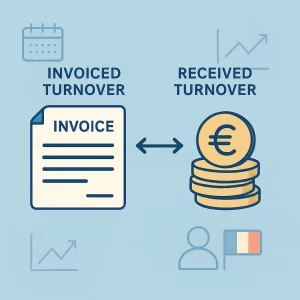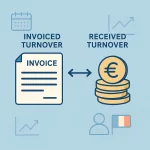Understanding the difference between invoiced turnover and received turnover is essential for managing your micro-entreprise correctly. It’s not about how much you’ve earned — it’s about when you earned it.
A Common Mistake Among New Micro-Entrepreneurs
When you’re just starting out as a micro-entrepreneur, it’s easy to assume:
- Invoiced turnover is the amount stated on the invoice.
- Received turnover is what actually reaches your bank account, after platform fees, commissions, and so on.
However, this interpretation is inaccurate from an accounting perspective. These two terms refer to different dates, not different amounts.
Invoiced vs Received Turnover: It’s All About the Date
In accounting:
- Invoiced turnover is linked to the date the invoice is issued.
- Received turnover is linked to the date the payment is received.
Example:
You issue an invoice on 10 January.
Your client pays you on 5 March.
- The turnover is invoiced in January.
- But it is received in March.
The Standard Rule in Business Accounting
In most traditional businesses, revenue is recorded based on the invoice date. Payments are reconciled upon receipt, but tax declarations are based on the date of the invoice.
The Specific Rule for Micro-Entreprises in France
Here’s the good news: as a micro-entreprise in France, you follow a simplified tax system. You only declare your turnover when the payment is actually received — based on the payment date, not the invoice date.
In the previous example:
- Invoice issued: 10 January
- Payment received: 5 March
You would declare that turnover to URSSAF in March, not January. This way, you don’t pay contributions on money you haven’t received yet.
Important: No Expenses Deducted from Turnover
As a micro-entreprise, you cannot deduct fees or commissions. The full amount on the invoice must be declared — even if a platform or bank retains a portion.
Example:
If you invoice €100 and receive €95 after fees, you still declare €100.
In Summary: Focus on Dates, Not Amounts
When someone talks about invoiced turnover or received turnover, they’re not asking how much you’ve earned or received.
They’re referring to:
- The invoice date (invoiced turnover), and
- The payment date (received turnover).
And for your micro-entreprise, only the date of payment matters for your declarations.
❓ What does “invoiced turnover” mean in a French micro-entreprise?
It refers to the amount stated on an invoice, based on the date the invoice was issued. However, this date is not used for tax declarations in a micro-entreprise.
❓ What does “received turnover” mean?
It’s the total amount shown on the invoice, declared when the payment is actually received in your bank account. This is the only figure that matters for URSSAF declarations.
❓ Should I subtract platform or banking fees from the amount I declare?
No. As a micro-entrepreneur, you must declare the full amount on the invoice, even if a portion was kept by a platform or bank.


